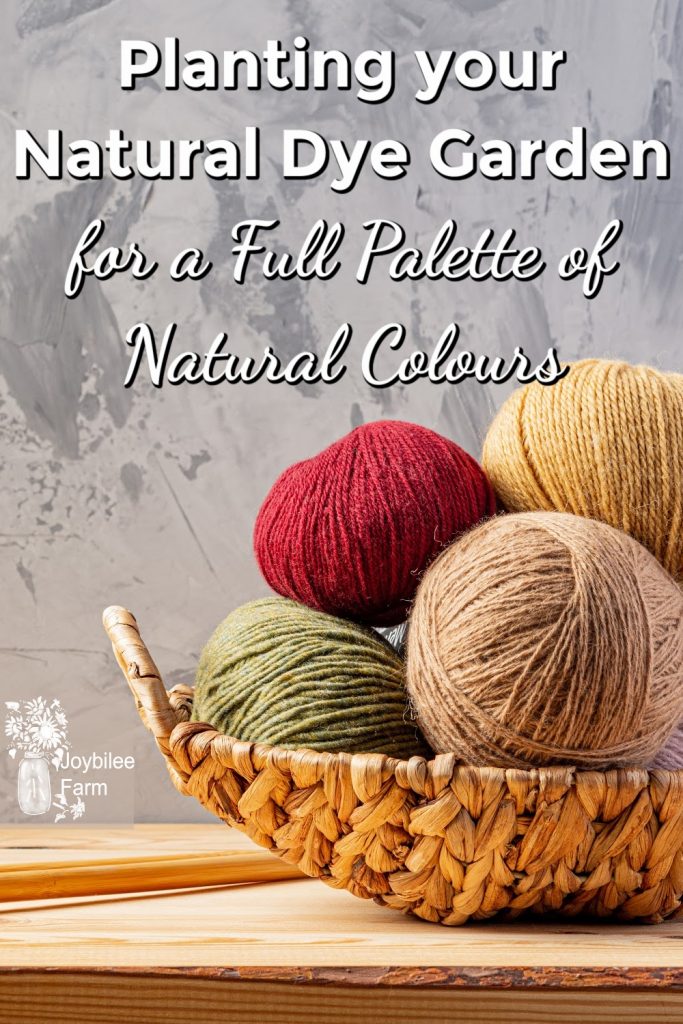Planning your natural dye garden:
A natural dye garden will give you eco-friendly, natural dye pigments for textiles, knitting yarns, soap making, and even artist paints and pastels and children’s art supplies. This year, put aside a portion of your garden, that you normally dedicate to flowers and herbs, to plant a rainbow of natural dye plants. Many common medicinal herbs are also traditional dye plants. Wean yourself from chemical colours and imported cookie-cutter fashion. And plan your wardrobe around nature’s palette.

Natural dyes are beautiful and aesthetically pleasing. Each natural dye colour is made up of several molecules of colour. Where chemical dyes are usually one colour molecule or just two colour molecules, natural dyes contain many pigments in each colour that our eyes see. This is why with chemical dyes when we put two reds together that don’t match, it jars our sense of beauty. We say it clashes.
Not so with natural dyes. All natural dyes go together because of the many colour molecules in each pigment. There’s a biochemical reason for this. Each plant or insect colour has several chromophores that make up the colour that we see. The chromophores that adhere to your cloth can be shifted by changing the pH of the solvent that you extract the colour with or by adding mordant salts or metals to the cloth to give the dye chromophores receptor sites on the textiles. The mordant salts include alum, calcium, magnesium, iron or copper, among the mordants that are nontoxic and safe to use at home.
I recommend planning your garden around both perennials and annuals, with a thought to the colours that each plant gives. Aim to have the three primary colours – blue, red, and yellow – represented in your garden in abundance. From these, a full rainbow of colours will be available to you.
By planning for several yellows, you will also have many greens and oranges to choose from. In my cold, short season climate, many traditional dye plants are inaccessible to me unless I want to buy imported dyestuffs like cochineal, an insect dye from that female scale insect that breeds on the prickly pear cactus. However, by embracing a bioregional palette and creating within that limitation, inspiration and creativity abound.
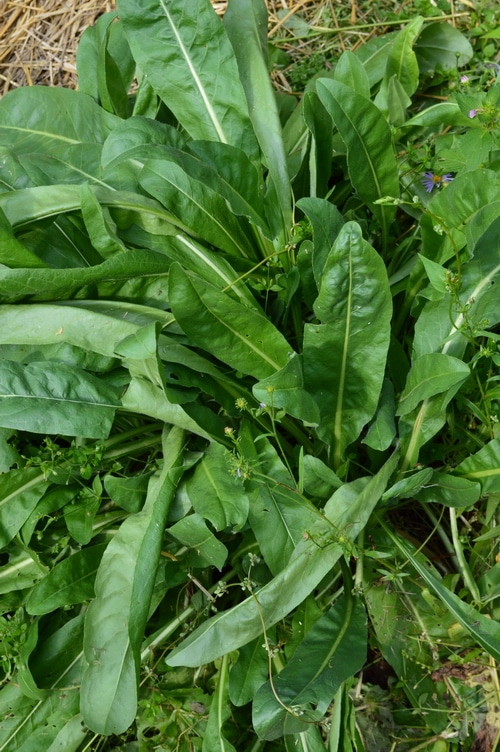
Blue
In my climate, woad (Isatis tinctoria) will grow very well. It is impervious to summer frost. Its long taproot and extensive root system, allow it to thrive when temperatures soar in July and August and yet continue to grow extra leaves and produce blues until it is buried by snow in November.
Woad is a biennial and its second year plant sends up broccoli-like stems (which are edible and quite hot, and mustard-like — it is a starvation food source). One plant will produce thousands of seed, and once the flower heads open the plant is almost impossible to remove from your soil. So please, please, please remove it in the Fall of its first year, once you’ve taken the last leaf harvest for your dye vat. If you leave it to go to seed, please be diligent to pull out all volunteers. I can’t stress this enough. Be responsible if you let it go to seed. There are actually several subspecies of woad. Isatis indigotica is frost sensitive and will bolt if subjected to colder temperatures during its first year. Another Isatis ssp. is grown in Norway but seeds, while available in the wild there, are not available commercially. Find out more about the specifics of dyeing with woad from Sarah’s website.
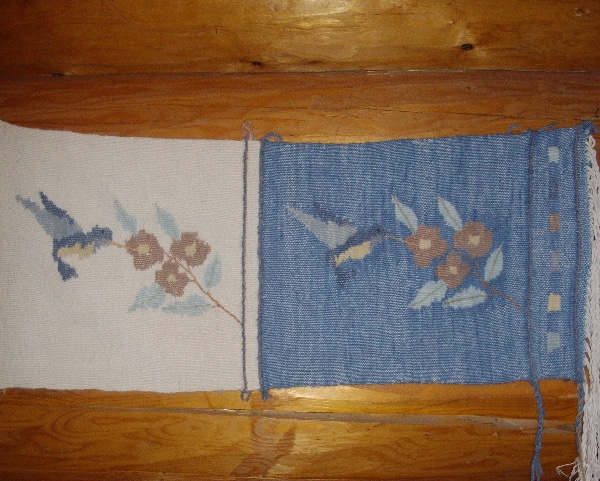
Every colour comes from woad, a prolific and generous dye plant.
Red
In my climate, there are several reds to choose from. The commercial red that is used by traditional dyers is Madder. Madder requires deep, rich soil and a long, warm season to produce seed. However, the dyestuff is found in the root and the plant may be propagated through root cuttings, so it is not necessary to have a seed. However, madder plants need to grow for 4 to 6 years and develop pencil thick roots to produce a strong dye.
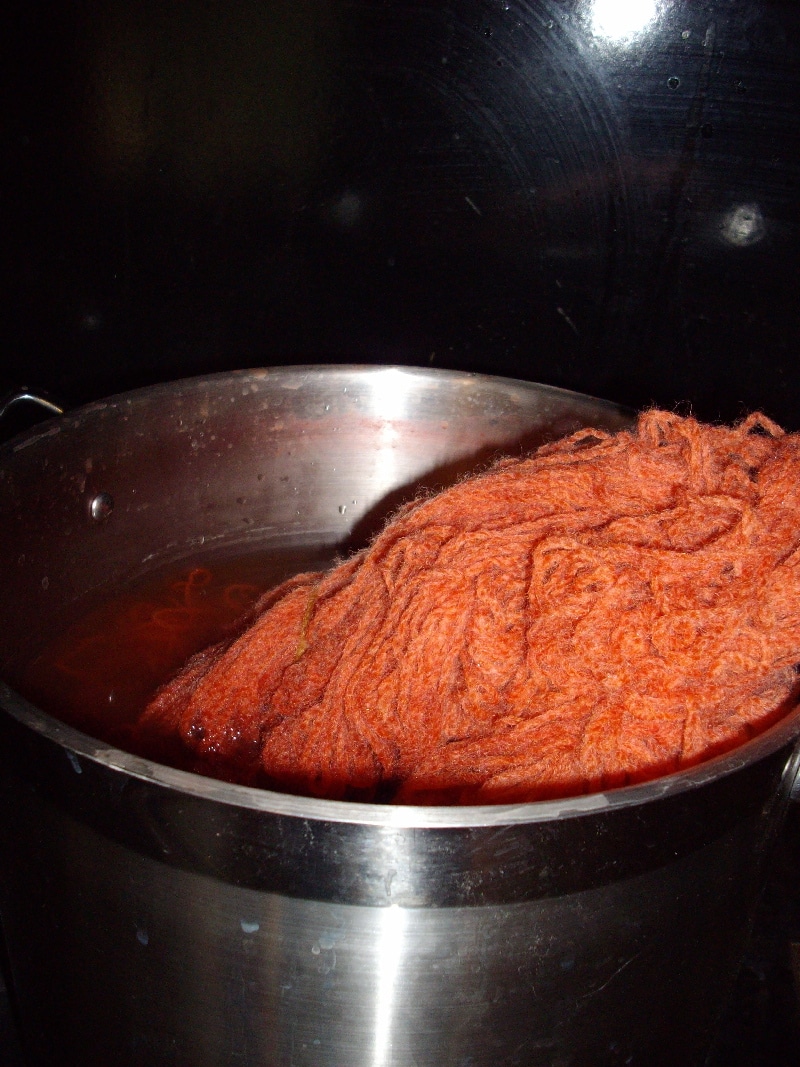
In a colder climate you will want to have 4 gardens beds, deeply tilled and amended with composted manure, for your madder garden. Madder plants themselves make an interesting ground cover. They sprawl across the ground with their Velcro like leaves, hiding the potential richness of colour beneath the soil. Madder likes calcium so the bed should be well limed before planting.
Goats and Cows that eat madder plants give pink milk, and if they have a steady diet of madder their bones will dye orange. Bedstraw or cleavers is another plant with red dye in the roots. It grows wild in my area. The leaves look like a daintier version of madder, with a square stem and Velcro like leaves. You will need a lot more roots for your dye, but bedstraw is so prolific that taking a few plants will leave much more to produce next year.
Bed-straw was used in Scotland and Northern Europe as a red dye for home use until the commercialization of chemical dyes.
Yellows
Perennials:
Dyer’s Chamomile or Dyer’s Margarite grows without coaxing. It will seed prolifically, and form a bank of many stems in your garden. It can be cut back for dyeing several times during the growing season before the flowers are allowed to set seed. You can use just the flower heads or both flower heads and stems. The perennial will last many seasons if cut back to the ground before the leaves begin to form in the Spring.

Yarrow is another prolific natural dye plant as well as a medicinal herb. Yarrow is a perennial that produces a flowering head with many flowers on each stem. There are several colour varieties to add interest to your garden. Check the zone requirements in your seed catalogue before ordering. While wild yarrow is hardy to zone 2, some of the recent colour varieties need a much warmer climate.
To dye with yarrow cut the flowering tops off just above the leaves and leave the plants in the ground for next season. They will reliably produce year after year even in poor conditions and in rocky soil.
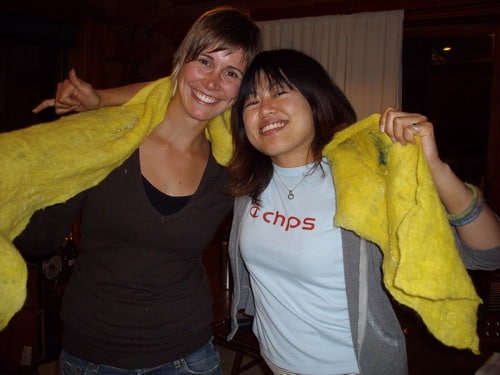
Golden Rod dyed and felted scarves by Heike and Aki.
Canadian Golden Rod is a prolific plant that can be harvested every season during flowering, once the plants are established. It will grow 3 to4 feet in height with a spread of 3 feet when planted in rich soil in a sunny location. To use for dyeing harvest the flowering tops. It is a rich, warm, golden yellow. To save the color for future dyeing, extract the dye in alkaline water and freeze the strained dye bath. Dried plant material loses a lot of its chromophores when stored. Golden rod gives a warm golden yellow that is reliably colorfast and washfast.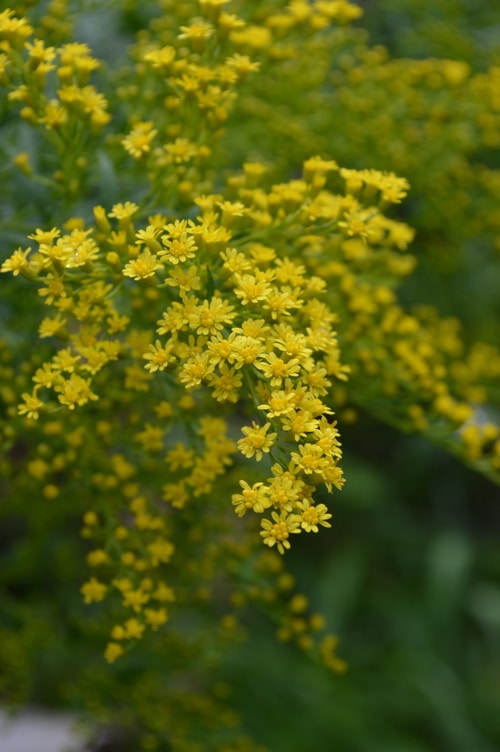
Biennials:
Weld is the traditional dye plant for yellow dye. It is valuable because it will produce a reliable and colourfast yellow even after the plants have been dried for future use. The seed is extremely tiny. Broadcast it in the prepared bed and firm in, leaving it on the soil surface to grow for two years. The first year it will form a rosette with fine, oblong leaves and a deep taproot.
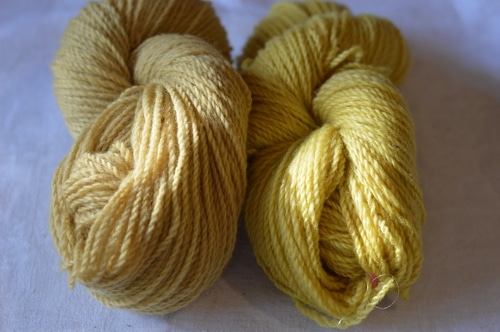
In the second year, it sends up several long stems that will grow a great many fine flowers. You wait until the flowers have set seed and the seed is almost mature before harvesting. I dry it by turning the plant upside down in a paper bag and hanging it in an airy room. Once dry the seeds can be collected. And the leaves and stems of the plant used for a rich, yellow dye bath.
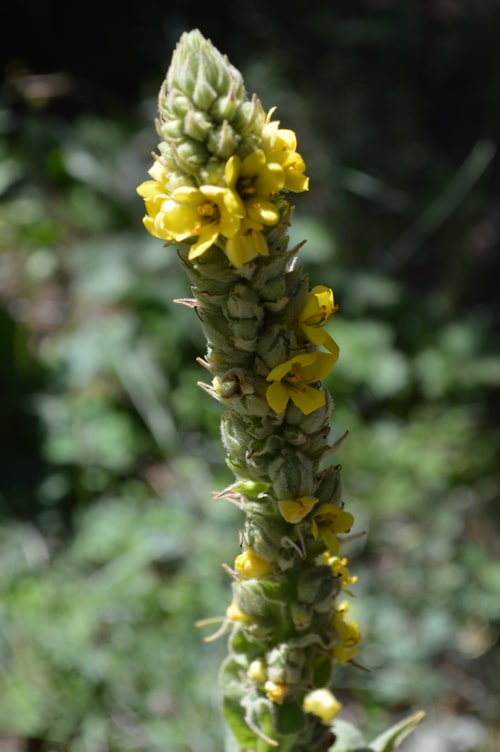
Mullein is a biennial that forms a woolly rosette in its first year and sends up a towering, candle-like flowering stalk the second year. You dye with the flowering stalk. The mullein stem has many fine hairs that become airborne when you handle it and cause irritation. Wear gloves and a mask when tearing it apart for dyeing to protect your hands and lungs.
Mullein is especially helpful for dyeing cotton because it is a natural source of tannins as well as yellow dyestuffs. It can be dried for tannins but should be used fresh for yellow dyes. It helps to add a bit of washing soda to the extraction vat. In Turkey, the natural dyers give mullein dyed wool an after bath in iron to shift the colour to tan, brown, and even black, for carpet weaving.
Annuals:
Coreopsis gives a warm, sunny orange, as well as yellow to the dye bath. It’s a prairie wildflower, that grows well if protected from frost. Take the flower heads for your dye bath and use them fresh. The first dip in the dye vat gives a deep, warm orange. Put a second and third skein in once the orange is removed, and you will get paler shades of yellow.
The plant will grow in a shorter season area. This plant is iffy for me depending on how long I can keep it protect from temperatures below freezing. If the plants are exposed to frost before flowering it doesn’t seem to matter, but once the flower buds appear, frost will kill the plant. If this happens to you, you can still get a yellow dye by harvesting the damaged stems, but you won’t achieve the brilliant oranges that will come if the plant is given its full allotment of sunshine.
This is not an exhaustive list. Many other plants can be used as natural dye sources for yellows. Barks from tree prunings, leaves, and needles are all potential sources of natural dyes. Soils rich in iron can also be used for dyeing. There is an abundance of dye material in nature just waiting for you to go for a walk in the woods. But having a few colour sources close to home in your garden means that you are more likely to use them.
A world of natural pigments awaits your creative expression, and it can be as close as your garden.
More Natural Dye Garden Inspiration
7 Medicinal Herbs that You Can Dye With
Make a Rainbow with These 5 Natural Dye Garden Plants
How to Make Ink From Natural Dyes
Eco-prints with Woad and Weeds
Botanical Prints, the story of natural dyer Suzanne Dekel
How to Ecoprint on Silk with local plants
Your turn:
Which natural dye plants are you ready to try in your natural dye garden?


